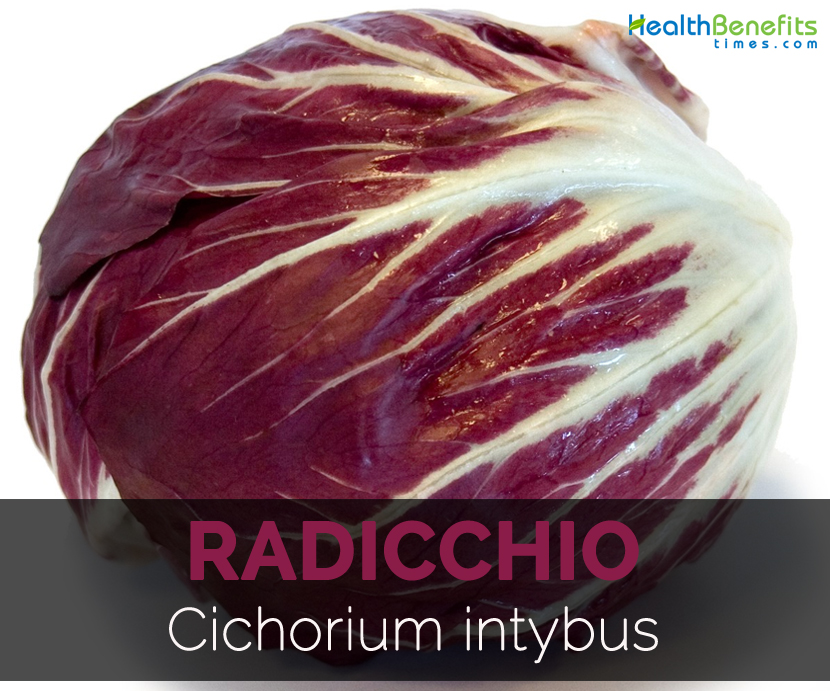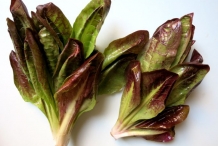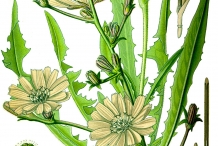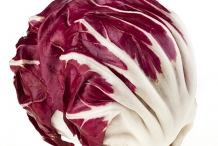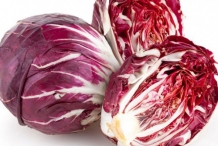It is a perennial plant usually grown as an annual. The plant bears the upright, elongated heads, conical in shape which is 3- 5 inches across. The heads are bronzy green- magenta or wine red colored. Its leaves are thin with white veins.
History
Radicchio is native to Mediterranean region which can also be found in North America and Asia.
During ancient times, it was consumed for purifying blood and to treat insomnia. The plant was modernly cultivated in 15th century. In 1860, the Belgian agronomist named Francesco Van den Borre used imbianchimento, blanching or preforcing technique to create dark red with white veins.
Nutritional value
Raw Radicchio consists of 37.26 grams of water, 0.4 grams of fiber, 0.28 grams of carbohydrate and 0.57 grams of protein per 40 grams. The minerals present in the Radicchio are calcium (0.80%), iron (0.23 mg), magnesium (1.19%), phosphorus (2.29%), potassium (2.57%), sodium (0.60%), zinc (2.27%) and others. It provides only 9 calories and 0.1 grams of fat.
Health Benefits of Radicchio
Besides its bitter taste, Radicchio is a great source of vitamins, dietary fiber and minerals. It also provides phytonutrients and antioxidants. It is fat as well as cholesterol free and also have low amount of calories. It is an excellent source of potassium, selenium, calcium, Vitamin C, Vitamin A, Vitamin E, Vitamin K, folate and Vitamin B. It maintains the cholesterol as well as blood pressure levels along with improving concentration.
- Heart ailments
Vitamin K helps to prevent arteries calcification which is one of the major causes for heart attacks. It carries calcium out of arteries and does not allow forming into harmful and hard deposits of plaque. It prevents the hardening of arteries.
Vitamin K helps to reduce inflammation and prevents the cells which line the blood vessels such as arteries and veins. Vitamin K helps to maintain the blood pressure and reduces the risk of having cardiac arrest.
- Healthy bones
Vitamin K increases the protein content which is needed to maintain the calcium in bones that lowers the chances of osteoporosis. The body requires Vitamin K for using calcium to form bones. The evidence shows that Vitamin K reduces the chances of bone fractures by enhancing the bone health. The high intake of Vitamin K2 reduces the chances of hip fracture by 65%.
The evidence shows that Vitamin D and Vitamin K works together in order to enhance the density of bones. Vitamin K has the positive effect on the balance of calcium which is required for the metabolism of bones. The intake of foods rich in Vitamin K by the injured patients helps to heal the broken bones and prevent twisted ankles.
- Relieves pain
Vitamin K lowers the PMS cramps and menstrual pains as it regulates the functions of hormones. Vitamin K also acts as a blood clotting agent by preventing over bleeding during menstruation and also relieves the symptoms of PMS. Over bleeding is the cause for more pain and cramps during menstruation. The research shows that the deficiency of Vitamin K could worsen the symptoms of PMS.
- Treats cancer
Vitamin K can reduce the chances of colon, nasal, prostate, stomach and oral cancer effectively. The research shows that high intake of Vitamin K assists the liver cancer patients by improving their functions of liver. The study shows that high intake of Vitamin K helps to lower the chances of cancer and cardiovascular.
- Brain health
Vitamin K is essential for the brain health. It involves in the sphingolipid metabolism which are the molecules widely found in the cell membranes of brain.
A study found that vitamin K dependent proteins are particularly important for the brain. Vitamin K involves in the nervous system by involving in sphingolipid metabolism, which is a class of molecules that occurs naturally and is present in the brain cell membranes.
The evidence shows that Vitamin K has anti-inflammatory properties which prevent the brain from oxidative stress caused due to damage made by free radicals. Oxidative stress may lead to the development of Alzheimer’s, cancer, Parkinson’s as well as heart failure.
- Metabolism
Copper is essential for the reactions of 50 various metabolic enzymes that takes place in the body normally. The enzymes reactions are essential for the proper functioning of metabolism which allows nerve for communication.
The copper enzymes are found in large number with high brain, liver and heart metabolic activities. Copper is required for the cardiovascular system, nervous system, digestive system and metabolic process. Copper is also required for ATP (adenosine triphosphate) which is the source of energy for the body. The deficiency of copper may lead to slow metabolism, poor metabolic health and low energy.
- Reduce arthritis
Copper possess an anti-inflammatory properties which provides relief from the stiffness and pain related to arthritis. It assists the strength of muscles, repairs connective tissue and lowers the joint pain. The arthritis patients wear copper bands or bracelets with a belief that it can reduce the painful symptoms of arthritis.
- Thyroid function
Copper is required for the proper function of thyroids as it works with potassium, zinc and calcium which help to balance the thyroid activities and prevents hyperthyroidism or hypothyroidism. Due to the complex relationship of the trace minerals, the rise in one should be balanced by other. Due to the excessive presence or deficiency of these minerals, the thyroid takes place. It leads to weight loss or gain, fatigue, chance in appetite or body temperature.
- Treats anemia
Iron and copper work together to synthesize the red blood cells and hemoglobin. The studies show that copper is vital for the iron absorption from an intestinal tract and releases it into liver where it is stored. The iron level decreases with the deficiency of copper due to which the anemia could develop. The anemia patients could experience the symptoms such as muscle aches, fatigue, impaired brain function and digestive problems.
- Prevents neurodegenerative disease
The copper may help the conditions of neurodegenerative disorders such as Parkinson’s or Alzheimer’s disease. The high intake of copper could be toxic and results in poising of copper and impairments of brain function. The research shows that the deficiency of copper increases the chances of impaired brain function and cognitive decline.
Traditional uses
- It helps to tone liver and purifies the blood as it possesses antioxidant properties.
- Radicchio can provide relief to the insomnia patients.
- The juice extracted from Radicchio is used in cosmetics to ease irritated skin.
How to Eat
- In Italian cuisine, it is grilled in olive oil and mixed into dishes known a risotto.
- The roots can be mixed with coffee.
- It is served along with pasta as a poultry stuffing or as a part of tapenade.
- Radicchio is used as a garnishes or salads.
- It is consumed raw, roasted or grilled.
- In Italy, Radicchio is added to tomato sauces and risottos or grilled also dressed in an olive oil.
- Radicchio could be grilled with olive oil, salt, flour and fried which could accompany meats.
- Radicchio can be baked or sautéed.
- The cooked radicchio could be added to soups, pasta, rice, legumes, tofu and omelets.
- Radicchio could be used to hold tuna, chicken or seafood.
- Radicchio could be tossed with olive oil and top with cheese which is broiled till the leaves turn to reddish brown.
- Radicchio is irresistible part of Italian cuisines.
Other Facts
- During the Roman Empire, the purifying properties of Radicchio were well-known.
- Ancient Romans used Radicchio to treat insomnia.
- The substance called Lactucopicrin which is extracted from Radicchio possesses anti-malarial, pain-killing and sedative properties.
- Veneto region of Northern Italy is well-known for cultivating Radicchio.
- In Southern Europe, Radicchio is popular and commonly consumed.
- The pollination is done by insects.
Comments
comments
| Radicchio Quick Facts | |
|---|---|
| Name: | Radicchio |
| Scientific Name: | Cichorium intybus |
| Origin | Mediterranean region which can also be found in North America and Asia. |
| Colors | Bronzy green- magenta or wine red, white veins (Fruit) |
| Shapes | Upright, elongated heads, conical; Across: 3- 5 inches (Fruit) |
| Taste | Bitter, spicy (Leaves) |
| Calories | 9 Kcal./cup |
| Major nutrients | Vitamin K (85.08%) Copper (15.11%) Vitamin E (6.00%) Vitamin B9 (6.00%) Vitamin C (3.56%) |
| Health benefits | Heart ailments, Healthy bones, Relieves pain, Treats cancer, Brain health |
| More facts about Radicchio | |
